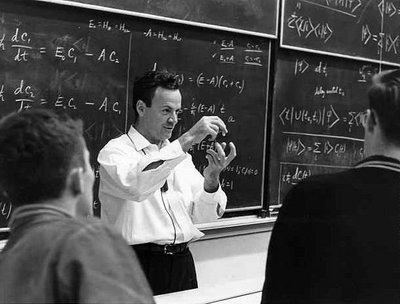Modern 2:More on Eigenfunctions and Measurements
| Line 8: | Line 8: | ||
===More on the time/energy uncertainty relation=== | ===More on the time/energy uncertainty relation=== | ||
| − | In quantum mechanics time plays a fundamentally different role than other observables. Conisder | + | In quantum mechanics time plays a fundamentally different role than other observables. It is not an operator, like position and momentum, it is a parameter which incrases during the course of experiments. We are conscious not so much |
| − | [http://www.bipm.fr/en/si/si_brochure/chapter2/2-1/second.html the | + | of time itself but of the passage of time. If I showed you two apparently identical photographs of an outdoor scene take exactly one year apart under identical lighting conditions, you would not know that a year had passed. But if I showed you the same scene in winter and summer, the passage of time would be clear. |
| + | |||
| + | |||
| + | |||
| + | Conisder the official definition of time | ||
| + | [http://www.bipm.fr/en/si/si_brochure/chapter2/2-1/second.html from the BIPM ] | ||
The second is the duration of 9 192 631 770 periods of the radiation corresponding to the transition between | The second is the duration of 9 192 631 770 periods of the radiation corresponding to the transition between | ||
Revision as of 15:31, 1 March 2006
I think I can safely say that no one understands quantum mechanics. -- R.P. Feynman
Notice the Dirac bra-kets on the blackboard.
More on the time/energy uncertainty relation
In quantum mechanics time plays a fundamentally different role than other observables. It is not an operator, like position and momentum, it is a parameter which incrases during the course of experiments. We are conscious not so much of time itself but of the passage of time. If I showed you two apparently identical photographs of an outdoor scene take exactly one year apart under identical lighting conditions, you would not know that a year had passed. But if I showed you the same scene in winter and summer, the passage of time would be clear.
Conisder the official definition of time from the BIPM
The second is the duration of 9 192 631 770 periods of the radiation corresponding to the transition between the two hyperfine levels of the ground state of the caesium 133 atom.
In other words, the frequency of the photons which are resonant with this transition in the ground state of Cs is exactly 9192631770 Hz = 9.192631770 GHz
ultra narrow spectra in a modern atomic clock
The key idea is: the longer the lifetime of an excited state, the narrower its spectral line. Mathematica notebook on time/frequency uncertainty for Gaussians
But what we really measure is not time at all, it's frequency.
Never measure anything but frequency: Arthur Schawlow
Shawlow was the co-inventor of the laser and got the Nobel Prize in 1981. Schawlow's very interesting Nobel lecture
